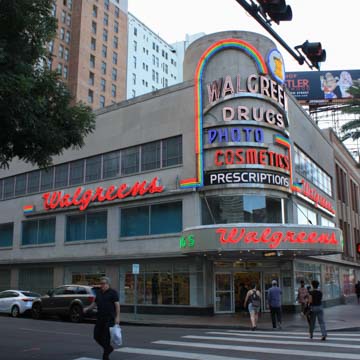Pharmacist Charles Walgreen established his drugstore chain in Chicago in 1901. The smooth, streamlined exterior of this steel-framed store suits the corner site it occupies and conveys a fresh, healthy image. A low, round tower wrapped by blue and red neon signage (added c. 1949) marks the corner entrance. Inside, retail departments and a one-hundred-foot-long lunch counter originally occupied the ground floor, the second floor housed a restaurant and kitchen, and the third floor was used for storage. In 1997, Walgreens proposed demolishing the drugstore in order to build a larger structure, but local preservation organizations prevented this; the distinctive neon sign has since been landmarked. The similarly designed neon sign on the CVS Pharmacy (formerly the Gus Mayer department store) nearby at 800 Canal is a 2010 addition to the 1940 building.
You are here
Walgreens Drugstore
If SAH Archipedia has been useful to you, please consider supporting it.
SAH Archipedia tells the story of the United States through its buildings, landscapes, and cities. This freely available resource empowers the public with authoritative knowledge that deepens their understanding and appreciation of the built environment. But the Society of Architectural Historians, which created SAH Archipedia with University of Virginia Press, needs your support to maintain the high-caliber research, writing, photography, cartography, editing, design, and programming that make SAH Archipedia a trusted online resource available to all who value the history of place, heritage tourism, and learning.


